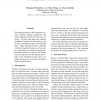Free Online Productivity Tools
i2Speak
i2Symbol
i2OCR
iTex2Img
iWeb2Print
iWeb2Shot
i2Type
iPdf2Split
iPdf2Merge
i2Bopomofo
i2Arabic
i2Style
i2Image
i2PDF
iLatex2Rtf
Sci2ools
ACL
2007
2007
Classifying Temporal Relations Between Events
This paper describes a fully automatic twostage machine learning architecture that learns temporal relations between pairs of events. The first stage learns the temporal attributes of single event descriptions, such as tense, grammatical aspect, and aspectual class. These imperfect guesses, combined with other linguistic features, are then used in a second stage to classify the temporal relationship between two events. We present both an analysis of our new features and results on the TimeBank Corpus that is 3% higher than previous work that used perfect human tagged features.
ACL 2007 | Computational Linguistics | Temporal Attributes | Temporal Relations | Temporal Relationship |
| Added | 29 Oct 2010 |
| Updated | 29 Oct 2010 |
| Type | Conference |
| Year | 2007 |
| Where | ACL |
| Authors | Nathanael Chambers, Shan Wang, Daniel Jurafsky |
Comments (0)

